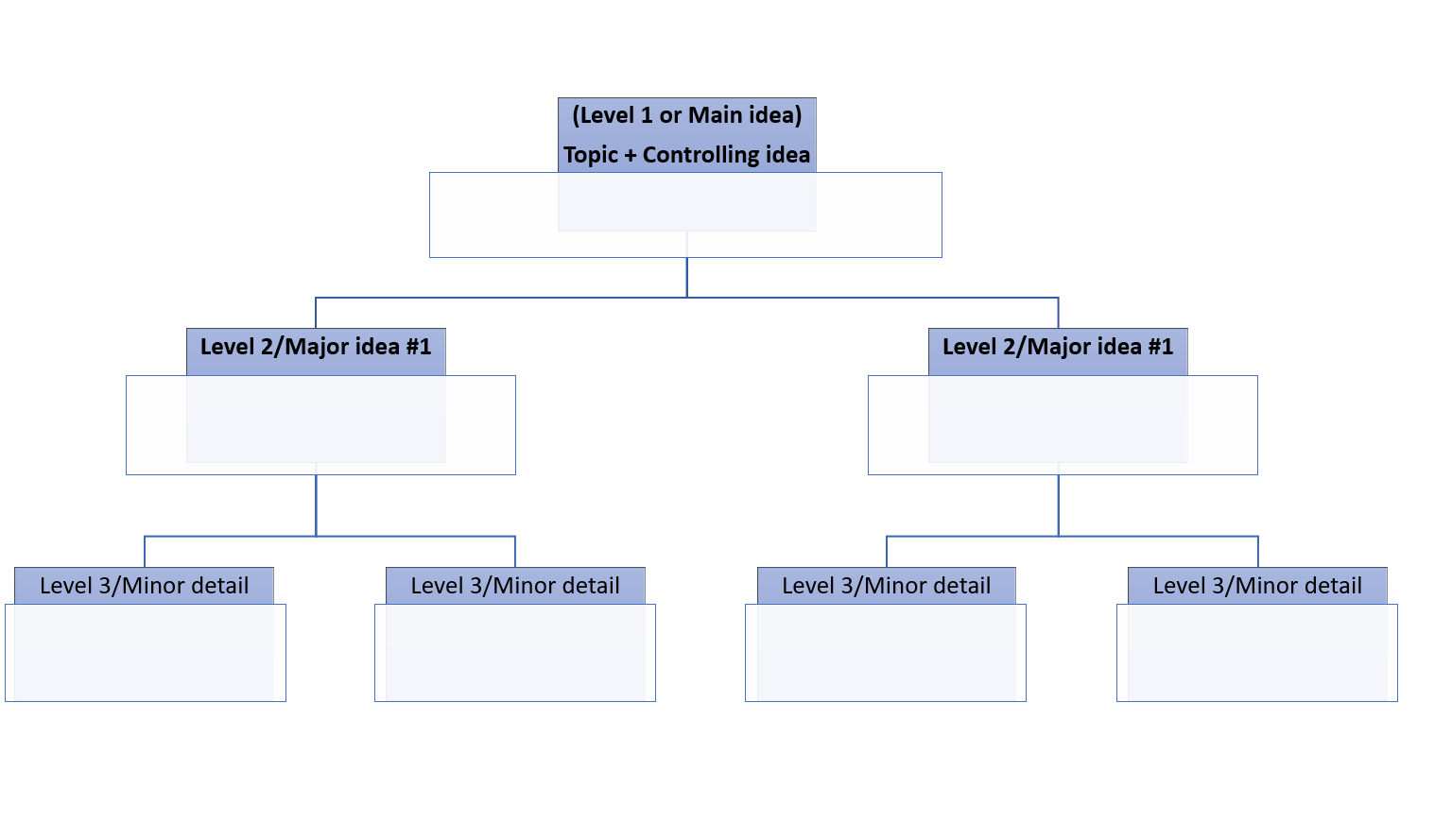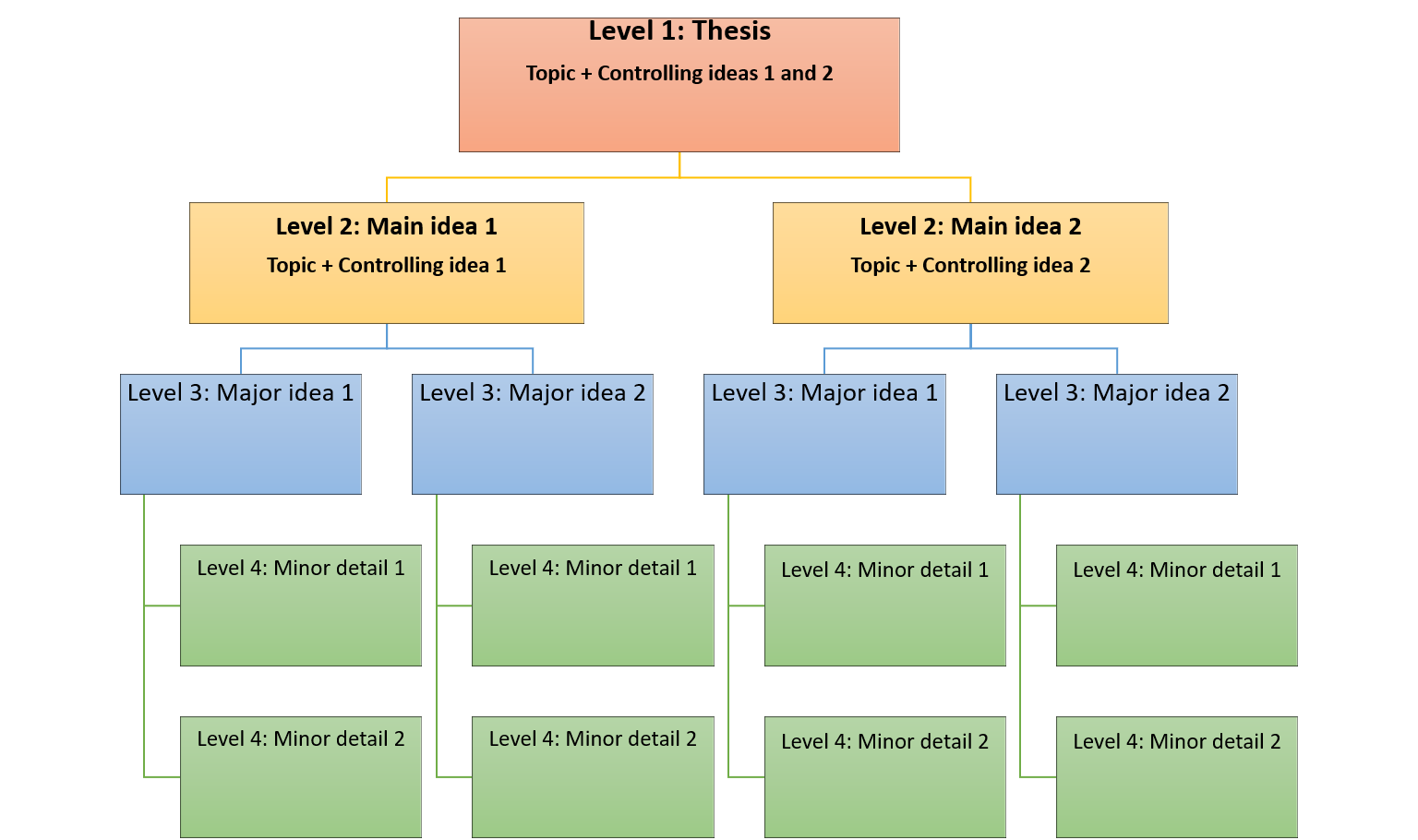Academic Module 1: Creating Academic Content
14
U.S. college courses often require students to compose written assignments, ranging from short answer questions of a few sentences to much longer multi-page papers. Regardless of the length of the composition, all written assignments require students to complete specific steps (process) to reach the desired outcome (product). Generally, when students work on composition assignments, they complete the following steps: brainstorming, creating a graphic organizer, making an outline, creating the first complete draft, and editing/revising. As students advance in their acquisition of academic English and take on longer, more complex composition assignments, they often complete more than one cycle of drafting, editing, and revising.
In this chapter, you will learn more about each of the key steps in composing (a four-paragraph essay, for instance) as part of meeting your ELAI 990 learning outcomes as well as using the APP strategy of composition writing.[1]
The steps in composition writing
Generally, students may complete five steps when they compose a paragraph or an essay. This is especially helpful when students are less familiar with the process of composition writing. As students become more familiar, they may be able to successfully consolidate some of these steps, especially when they write timed in-class compositions.
Step 1: Brainstorming
Have you ever heard the term ‘brainstorming’ before? What do you think this refers to?
If you look up the term in a dictionary, you may come across the following definition: “generating ideas through group discussion”. This is accurate. However, students may not always have a group to generate ideas for assignments, and it is helpful to learn how to do simple brainstorming by oneself as well.
Let’s focus on the first part of the dictionary definition: ‘generating ideas’.
When you come across a topic for the first time, it is helpful to take a piece of paper (or on a computer/tablet/smartphone) and write down some initial ideas that come to your mind related to the topic. At this stage, students may draw upon their knowledge in one or more languages. This is something that you likely do in your everyday tasks, especially if you grew up in a bilingual/multilingual environment. In addition, students have a very strong command of a language other than English may also find it helpful to do the initial brainstorming in that language and then transition to English. At this stage, it is the ideas that are more important, regardless of what language they are expressed in.
To generate ideas, you may create a very simple idea map where you write the main topic in the center and then write down, clustered around that topic, one or two words or a very short phrase that comes to your mind and is connected to the topic (you may even draw a line from the topic to the new related ideas that you are expressing in the form of one or more words). By spending a few minutes on completing this simple task, you can quickly identify what you already know about the topic, all in one place in a visual form that’s easy to see. This will also give you more confidence that you do know something about the topic (sometimes students get stuck because they feel they do not know the topic at all). Finally, creating a simple brainstorming map will also help you figure out some of the gaps in your own knowledge about the topic–things that you do not know and need to know. This is especially handy when you already know what the composition writing task requires you to focus on (for instance, you may have to list causes or effects, or identify problems, or offer solutions, or take a position related to the topic).
Step 2: Creating a Graphic Organizer
At this step, students may start transitioning to (academic) English and use longer phrases to flesh out their ideas more and to organize those ideas in a graphic format across different levels of information. How many levels of information you identify at this step will depend on the APP of your assignment, but generally in a four-paragraph essay, students should list at least four levels of information in their graphic organizers: the thesis, the two main ideas (that will then become the topic sentences in the two body paragraphs), the major details to support the main ideas, and the minor details to support the major details. Remember, the more you move down the levels, the more specific the information will become.
Creating a graphic organizer will also help you identify the gaps in your knowledge that you need to fill in order to create a complete graphic. You may, for instance, need to find relevant facts to list as minor details or you will identify the academic English vocabulary items you need to know in order to fill in the different levels. A graphic organizer will also help you identify which information is less relevant or unnecessary and remove it from the organizer. For example, you may have three main ideas to support the thesis when you begin, but the parameters of the essay require you to use only two. At this step, you will identify which two the main ideas of the three to select, and you could select the best two based on importance, relevance, or parallelism. Finally, when you make a graphic organizer, you will be able to ensure that it is balanced, with a similar number of ideas for each of the body paragraphs that you will then outline in the next step.
Let’s look at the examples of a graphic organizer for a paragraph assignment and a graphic organizer for an essay assignment below to see how the ideas may be structured in a graphic organizer (To see the images in a larger format, click on each image). Keep in mind that the structure below is one example, and as you become more comfortable with making graphic organizers, you will be able to vary the structure based on the specific APPs of the assignments.
A sample graphic organizer for a paragraph assignment
A sample graphic organizer for a four-paragraph essay assignment
Step 3: Drafting an Outline
For longer composition assignments, such as multi-paragraph essays, creating an outline based on the graphic organizer can be very helpful, especially for students who struggle with writing longer sentences and creating flow within and across paragraphs. Let’s look at the examples of a paragraph outline and an essay outline below to see how outlines may be structured. Keep in mind that, just like a graphic organizer, the actual structure that you use for specific compositions will depend on the APP of the assignment.
A sample paragraph outline
-
- Topic sentence: _____________________________________________________________________________________________________________________
- Major detail 1: _____________________________________________________________________________________________________________________
- Minor details: _____________________________________________________________________________________________________________________
-
- Major detail 2: _____________________________________________________________________________________________________________________
-
-
- Minor details: _____________________________________________________________________________________________________________________
-
-
- Conclusion: _____________________________________________________________________________________________________________________
A sample essay outline
-
- Introduction
- Hook: _____________________________________________________________________________________________________________________
- Background information: _____________________________________________________________________________________________________________________
- Thesis statement: _____________________________________________________________________________________________________________________
- Body paragraph 1
- Topic sentence: _____________________________________________________________________________________________________________________
- Major detail 1: _____________________________________________________________________________________________________________________
- Minor details: _____________________________________________________________________________________________________________________
- Introduction
-
-
- Major detail 2: _____________________________________________________________________________________________________________________
-
-
-
-
- Minor details: ___________________________________________________________________________________________________________________
-
-
-
- Body paragraph 2
- Topic sentence: _____________________________________________________________________________________________________________________
- Major detail 1: _____________________________________________________________________________________________________________________
- Minor details: _____________________________________________________________________________________________________________________
- Body paragraph 2
-
-
- Major detail 2: _____________________________________________________________________________________________________________________
-
-
-
-
- Minor details: _____________________________________________________________________________________________________________________
-
-
-
- Conclusion
- Restatement of the thesis: _____________________________________________________________________________________________________________________
- Additional information: _____________________________________________________________________________________________________________________
- Closing strategy: _____________________________________________________________________________________________________________________
- Conclusion
Step 4: Composing the first full essay draft
The next step in the essay writing process is to take the outline and convert it into the first full essay draft, comprising four paragraphs, in this instance. At this stage of essay writing, students should focus on ensuring that the ideas flow logically within and across paragraphs, and that they use suitable transitional words, phrases, and sentences to connect the ideas. Students should also start paying attention to the word count at this point to ensure that they follow the guidelines provided. Once the first full draft has been created, students should use the rubric provided as well as a checklist to ensure that they have not forgotten some important element. For instance, if the rubric requires the student to make at least one reference to a reading, the student should ensure that they have done so by this stage.
Step 5: Revising the draft
As a final step in the composition assignment, students should both proofread and edit their compositions as needed. At this step, students should pay special attention to spelling words correctly, using appropriate punctuation and indentation, employing correct grammatical structures, and so forth. This may also be a good time to visit the Writing Center to get additional feedback, although you may visit the Writing Center at any stage of the composition assignment.
We are going to practice all of these steps in the class throughout the semester as well.
The APP of composition writing
Now, let’s look at the tasks of annotating and making notes through the lens of audience, purpose, and parameters, or APP.
Let’s start with the first criterion–the audience.
- When you write a paragraph (e.g. in the form of a short answer to a question) or a longer composition (e.g. a four-paragraph essay) or a multi-page assignment (e.g. a 10-page paper that you may have to write in a credit course), who is your audience? Generally, students write short and long compositions for their professor to read (and to demonstrate that they have understood the target concept or idea well). As a result, you must structure and customize the content in the paragraph(s) for your professor, in which case, you need to make decisions about which language you would use to communicate your ideas (e.g. English in a U.S. college course) and what tone/register would be appropriate (i.e. academic/professional). In other words, who your audience is informs what you say and what you write in a college course. Therefore, it is very helpful to identify clearly who the target audience is for any academic assignment.
Now, let’s look at the second criterion–the purpose.
- When you compose a text, it is essential that you keep the purpose or the reasons why you are writing the text in mind. For instance, is the purpose to describe, to inform, to persuade, or to convince? Depending on the purpose, you will need to choose the appropriate pattern of organization and the tone to use in your writing. For instance, if you write an essay where you have to provide two reasons why multilingualism is beneficial, you will need to use a persuasive tone and list two benefits of multilingualism along with details to describe these benefits in detail. Students who fail to do so or misidentify the purpose at the beginning of the composition process end up writing a composition that is off-topic or with the wrong focus.
Finally, let’s look at the last criterion–the parameters.
- In composing an assignment, you need to pay close attention to the guidelines provided to identify the assignment parameters, for instance in terms of word length, number of paragraphs, formatting, recommended font type and font size (for typed assignments), and so forth. This is especially helpful for students who may be new to college-level writing in general or the U.S. college culture specifically. When in doubt, check with your professor!
- As you advance in your academic careers, the composition writing tasks are likely to become more complex, such as in the form of multi-page essays and research papers. Such advanced composition tasks may require other steps in the process of essay-writing, and you will learn those skills in your credit courses. The steps you learn here will help create the foundation on which you will then advance in your academic writing in credit-based coursework. ↵


